

 |
 |
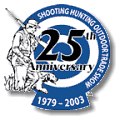 It was another banner year for knives with an exciting crop of new blades. In many respects the biggest news this year wasn't the knives as much as it was the growing enthusiasm for Crucible's CPM S30V high carbon stainless steel that was first introduced last year by Chris Reeve. Many of the manufacturers introduced one or more knives using S30V, some smaller makers are moving much of their production of high end blades in that direction. If anything, initial expectations for improved performance are being exceeded as manufacturers are developing a better understanding of how to get the most out of this new wonder steel.
It was another banner year for knives with an exciting crop of new blades. In many respects the biggest news this year wasn't the knives as much as it was the growing enthusiasm for Crucible's CPM S30V high carbon stainless steel that was first introduced last year by Chris Reeve. Many of the manufacturers introduced one or more knives using S30V, some smaller makers are moving much of their production of high end blades in that direction. If anything, initial expectations for improved performance are being exceeded as manufacturers are developing a better understanding of how to get the most out of this new wonder steel.
Assisted opening folders were again popular, but there were not nearly as many new ones as last year. By "assisted opening" we are talking about a spring-powered mechanism that opens the knife once you have started opening the blade. This is differentiated from an automatic (commonly referred to as a switchblade) that opens with just the press of a button or lever. Some will argue it is a distinction without a difference and many fear that assisted opening knives are a potential legal minefield, but for now they are legal in most places and the feds haven't made an issue of it. Mind you, laws against automatic knives are bogus anyway and were enacted in a moment of political hysteria, but that's another issue. In most cases the spring takes over almost immediately after you start opening the blade, thus for safety's sake, you really need to lock it closed and all such knives are equipped with safety locks, which pretty much defeats much of the supposed advantage the mechanism might provide. Forgetting to lock the safety can result in an assisted opening folder opening in your pocket, with resulting damage to your person or your clothing (been there, done that!).
It seems that the traditional drop point blade shape, our favorite, is making something of a small comeback, though nobody had any explanation as to why, other than it's a shape that works. Perhaps it's just one of those everything old is new again sort of things.
What follows are just the highlights.� We have provided the specifications we received from the manufacturers for the most part; some are much better than others in what they provide, so blame them if you are missing some spec you'd have liked to have seen.
Prices quoted are manufacturer's suggested retail price as of March 1, 2003 (we don't waste pixels, or your intelligence, on 95 cents, we just round up). Most gear covered here can be purchased at significantly discounted prices from those quoted.
This SHOT Show Report is split into three sections: Knives (including multi-purpose tools), Lights (including flashlights and headlamps) and Gear (everything else).� Click on the link in this paragraph or at the bottom of the page to get to the next section, or to any of the other sections.
Assembling this SHOT Show Report is a major undertaking for this one-man show. Please consider making a tax-deductible donation to the Equipped To Survive Foundation if you find this report to be of value to you. The Equipped To Survive Foundation is a tax-exempt non-profit corporation that supports the continued operation and expansion of Equipped To Survive™ and which allows me to attend shows such as this and report to you on the latest and greatest gear. In many cases Equipped To Survive™ has been first by months to publicize new and exciting survival and preparedness gear. Again, donations are fully tax-deductible. Click here to make a tax-deductible donation or to find out more. Thanks very much for your support and consideration.
 New this year from Al Mar is a pair of liner lock folders designed by Kirk Rexroat with stainless liners and VG-10 stainless blades. They both have removable stainless pocket clips, non-reversible, non-ambidextrous, but not a lanyard hole to be found.
New this year from Al Mar is a pair of liner lock folders designed by Kirk Rexroat with stainless liners and VG-10 stainless blades. They both have removable stainless pocket clips, non-reversible, non-ambidextrous, but not a lanyard hole to be found.
The "Nomad" ($189) has a 3-inch modified drop point blade with a 4-inch handle having textured G-10 scales. There's an integral thumb guard and the butt end kicks down providing a third finger hook. The blade has ambidextrous thumb studs, a thumb ramp and finger choil.
 The "Shrike" ($194), has a slim 4-inch clip point blade with a sleek curved 4.5-inch handle having black linen Micarta scales. There's a
thumb ramp, but no guard.
The "Shrike" ($194), has a slim 4-inch clip point blade with a sleek curved 4.5-inch handle having black linen Micarta scales. There's a
thumb ramp, but no guard.
 The S.E.R.E. Operator fixed blade got some upgrades this year; most notable being a switch to S30V blade steel.� It is now available also with a sawtooth back ($214) and the molded Prylon sheath has been improved with an extension behind about two-thirds of the handle and rubber handle snubber, allowing more carry options and better security.�
The S.E.R.E. Operator fixed blade got some upgrades this year; most notable being a switch to S30V blade steel.� It is now available also with a sawtooth back ($214) and the molded Prylon sheath has been improved with an extension behind about two-thirds of the handle and rubber handle snubber, allowing more carry options and better security.�
Both the Hawk and the Osprey gentleman's front lock folders are available with a new range of swanky scales. The Black Pearl Hawk ($180) is definitely eye-catching.
 Bear MGC's "SOS by Blackie Collins" is a patented self-sheathing fixed blade survival knife by one the industry's most prolific designers.� The articulated stainless blade guard rotates down and forward from the blade and then folds up and over on top of the skeletonized handle. A nib in the cover serves to hold it in place by simple friction.
Bear MGC's "SOS by Blackie Collins" is a patented self-sheathing fixed blade survival knife by one the industry's most prolific designers.� The articulated stainless blade guard rotates down and forward from the blade and then folds up and over on top of the skeletonized handle. A nib in the cover serves to hold it in place by simple friction.
The 3.25 inch traditional drop point blade and the handle are of "440A modified has
extra carbon." Overall length is 7.75 inches and the handle has hex cut-outs to fit 1/2, 7/16, 3/8 and 11/32 inch fasteners. The bottom of the handle has two long scallops and the top has a ridged thumb rest, but there's no real guard. A lanyard hole is provided, extending out of the butt on a little tailpiece so that it clears the blade cover when in the stowed position. The SOS weighs in at 4.5 oz. Bear asked that we emphasize this knife is made in the U.S.
 Benchmade The Model 310 "Benchmite" ($100) introduces a new locking
mechanism developed by Bill McHenry and Jason Williams, who also developed the
Axis Lock. This is a small drop point folder, only 2.85 in. closed with a 1.92
inch blade and weighing in at a single ounce. The 154CM blade is 0.08 in.
thick, retained by blue anodized titanium frame/scales. The "Levitator" locking
mechanism is integral with the frame.
Benchmade The Model 310 "Benchmite" ($100) introduces a new locking
mechanism developed by Bill McHenry and Jason Williams, who also developed the
Axis Lock. This is a small drop point folder, only 2.85 in. closed with a 1.92
inch blade and weighing in at a single ounce. The 154CM blade is 0.08 in.
thick, retained by blue anodized titanium frame/scales. The "Levitator" locking
mechanism is integral with the frame.
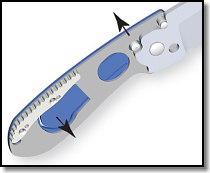 Pressing the tab at the rear raises the front of the locking mechanism, releasing the blade.� The blade locks closed and open, the tab must be pressed before opening the knife. A nail nick is provided for opening, this isn't a one-hand opening knife (though we were shown a prototype of one, as well as a prototype of an
automatic).� There is no clip, this is designed as a gentleman's pocketknife. There is a lanyard hole, however. It would make a dandy blade for a pocket survival kit, especially if the one-hand opening version makes it into production.
Pressing the tab at the rear raises the front of the locking mechanism, releasing the blade.� The blade locks closed and open, the tab must be pressed before opening the knife. A nail nick is provided for opening, this isn't a one-hand opening knife (though we were shown a prototype of one, as well as a prototype of an
automatic).� There is no clip, this is designed as a gentleman's pocketknife. There is a lanyard hole, however. It would make a dandy blade for a pocket survival kit, especially if the one-hand opening version makes it into production.
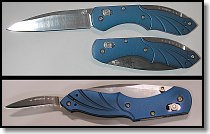 The Warren Osborne designed Model 921 "Switchback" isn't brand new, but this was its first showing at SHOT Show. This is Benchmade's first double blade knife. Unfortunately, only the main blade locks, via
benchmade's Axis Lock mechanism. This is also Benchmade's first blade using S30V steel; the smaller blade is 440C.� Both blades are modified wharncliff style, bordering on a slim drop
point. The large is 3.4 inches with a double stud for one-hand opening; the smaller is 2 inches with a nail nick.� Scales are blue anodized aluminum.
The Warren Osborne designed Model 921 "Switchback" isn't brand new, but this was its first showing at SHOT Show. This is Benchmade's first double blade knife. Unfortunately, only the main blade locks, via
benchmade's Axis Lock mechanism. This is also Benchmade's first blade using S30V steel; the smaller blade is 440C.� Both blades are modified wharncliff style, bordering on a slim drop
point. The large is 3.4 inches with a double stud for one-hand opening; the smaller is 2 inches with a nail nick.� Scales are blue anodized aluminum.
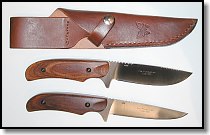 Benchmade also introduced a pair of traditonal style fixed blade knives, the "Model 190 Drop Point Hunter" and the "Model 192 Bird and Trout," both $100. These are full tang design with stabilized "hardwood" contoured scales for handles, utilizing many of the ergonomics of the tactical Nimravus. The full flat ground blades are a hair short of 4 inches of 440C stainless. A very deep integral guard and thumb rest help ensure safety. A leather sheath with belt loop and snap-over strap is included. Unfortunately, and incomprehensibly from our viewpoint, there's no lanyard hole.
Benchmade also introduced a pair of traditonal style fixed blade knives, the "Model 190 Drop Point Hunter" and the "Model 192 Bird and Trout," both $100. These are full tang design with stabilized "hardwood" contoured scales for handles, utilizing many of the ergonomics of the tactical Nimravus. The full flat ground blades are a hair short of 4 inches of 440C stainless. A very deep integral guard and thumb rest help ensure safety. A leather sheath with belt loop and snap-over strap is included. Unfortunately, and incomprehensibly from our viewpoint, there's no lanyard hole.
![]() Benchmade's Model 100 "River & Rescue" fixed blade ($95)is now available in with what Benchmade describes as a "fluorescent" yellow handle. That implies that it will glow (fluoresce) in the dark or under ultraviolet light, which it does not; an unfortunately all too common misuse of
the word.
Benchmade's Model 100 "River & Rescue" fixed blade ($95)is now available in with what Benchmade describes as a "fluorescent" yellow handle. That implies that it will glow (fluoresce) in the dark or under ultraviolet light, which it does not; an unfortunately all too common misuse of
the word.
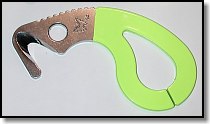 The Model 6H2O "Rescue Hook Handle" ($45), developed at the request
of users, provides a larger gripping handle to the Model 5 Rescue Hook
introduced last year. The larger handle is also powder coated in "fluorescent"
yellow for better visibility in an emergency.�
The Model 6H2O "Rescue Hook Handle" ($45), developed at the request
of users, provides a larger gripping handle to the Model 5 Rescue Hook
introduced last year. The larger handle is also powder coated in "fluorescent"
yellow for better visibility in an emergency.�
Finally, there are a few new colors for the Griptilian and
Mini-Griptilian lines, olive drab for both; yellow and a bright sky blue for
the Mini.
 From Boker's perspective, the big news was the introduction of a line of "AK-47" knives ($220, $350 limited editon) and watches, licensing the rights to the Kalahnikov name from Timofeevicj Kalashnikov, original designer of the famed AK-47 assault rifle. He was making appearances at the booth to appreciative audiences. The blade is similar in design to the ultra deep clip point of the AK-47 bayonet, not exactly a practical blade shape from our point of view, except perhaps if your last name is Simpson.
From Boker's perspective, the big news was the introduction of a line of "AK-47" knives ($220, $350 limited editon) and watches, licensing the rights to the Kalahnikov name from Timofeevicj Kalashnikov, original designer of the famed AK-47 assault rifle. He was making appearances at the booth to appreciative audiences. The blade is similar in design to the ultra deep clip point of the AK-47 bayonet, not exactly a practical blade shape from our point of view, except perhaps if your last name is Simpson.
 On a more practical and innovative note, the compact "Titanium Zeta" ($93) introduces a sintered titanium powder blade to folding knives. Boker claims that though the titanium is relatively soft, the "hard metal carbides" incorporated into the mixture before sintering provides a very aggressive cutting edge equal to any conventional steel in a blade that is 40% lighter, "will stay sharp longer than steel, will not rust and is flexible."� All of which would be good attributes.� The blade can be re-sharpened with conventional sharpeners, though finishing with a ceramic rod is recommended.
On a more practical and innovative note, the compact "Titanium Zeta" ($93) introduces a sintered titanium powder blade to folding knives. Boker claims that though the titanium is relatively soft, the "hard metal carbides" incorporated into the mixture before sintering provides a very aggressive cutting edge equal to any conventional steel in a blade that is 40% lighter, "will stay sharp longer than steel, will not rust and is flexible."� All of which would be good attributes.� The blade can be re-sharpened with conventional sharpeners, though finishing with a ceramic rod is recommended.
The 2.125 inch drop point blade is fitted with Delrin frame/scales, 3 inches closed and weighing in at 1.3 oz. Opening is by a right-handed thumb ledge. A stainless liner lock is inset into the Delrin and there's a lanyard hole, but no pocket clip.� Given the reported light weight of the blade, the overall weight seems high (we're talking relatively and mere tenths of ounces here) compared to similar sized lightweight folders.
![]() Boker has also formed a collaboration with Heckler & Koch, another name renowned in firearms.� The scales of the Boker HK knife are same textured fiberglass-reinforced Delrin used in H&K pistol grips with an aggressive anti-slip surface. Blades are available in tanto or drop point style with partial serration, in satin ($110) or titanium nitride black finish ($135).� The steel is Boker's X-15 T.N highly corrosion resistant stainless.� Lock-up is via an inset stainless liner lock.
Boker has also formed a collaboration with Heckler & Koch, another name renowned in firearms.� The scales of the Boker HK knife are same textured fiberglass-reinforced Delrin used in H&K pistol grips with an aggressive anti-slip surface. Blades are available in tanto or drop point style with partial serration, in satin ($110) or titanium nitride black finish ($135).� The steel is Boker's X-15 T.N highly corrosion resistant stainless.� Lock-up is via an inset stainless liner lock.
Surprisingly for a tactical based design, there's not much of a guard. A thumb rest and ridges top and bottom at the butt end help. The pocket clip and thumb disc are both ambidextrous and there is a lanyard hole.
 Boker introduced some new folders in their Magnum line starting with a series of folders incorporating their Top Lock pushbutton lock. Unnamed, these are designated models B0007 and B0017 for the drop point versions, bead blasted plain edge ($24) and black Teflon coated partially serrated edge ($25) blades, respectively. The 420 stainless blades are 3.25
inches long, 8 inches overall open.� Handles are aluminum with a lanyard hole and pocket clip and made in "the far east."
Boker introduced some new folders in their Magnum line starting with a series of folders incorporating their Top Lock pushbutton lock. Unnamed, these are designated models B0007 and B0017 for the drop point versions, bead blasted plain edge ($24) and black Teflon coated partially serrated edge ($25) blades, respectively. The 420 stainless blades are 3.25
inches long, 8 inches overall open.� Handles are aluminum with a lanyard hole and pocket clip and made in "the far east."
![]() The RY192 ($15) is a 3.375 inch drop point liner lock folder with stainless frame and G-10 scales. The 440 stainless blade has thumb stuff opener and a plain edge.� There's only a
slight guard, a pocket clip, but no lanyard hole, unfortunately.
The RY192 ($15) is a 3.375 inch drop point liner lock folder with stainless frame and G-10 scales. The 440 stainless blade has thumb stuff opener and a plain edge.� There's only a
slight guard, a pocket clip, but no lanyard hole, unfortunately.
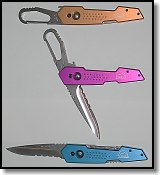 Buck KnivesThe "Revolution-XT" ($90) is another attempt at a
self-sheathing knife, and among the more functional such concepts we've seen
over the years. In this case the blade is retained in the anodized aluminum
handle while the tang, incorporating a wire spring clip, is exposed. The tang
also includes an integral bottle opener. To access the blade, the button lock
on the side is depressed to release the blade/tang� and the entire blade and tang is rotated 180 degrees until the tang is locked back into the handles. Reverse the process the sheath the blade.
Buck KnivesThe "Revolution-XT" ($90) is another attempt at a
self-sheathing knife, and among the more functional such concepts we've seen
over the years. In this case the blade is retained in the anodized aluminum
handle while the tang, incorporating a wire spring clip, is exposed. The tang
also includes an integral bottle opener. To access the blade, the button lock
on the side is depressed to release the blade/tang� and the entire blade and tang is rotated 180 degrees until the tang is locked back into the handles. Reverse the process the sheath the blade.
The blade is 3 inches of 420HC stainless with a 50/50 combination edge and a slip drop point profile. Overall length is 6.75 closed, 7.5 inches open. The handles come in five colors, black, blue, purple, green and orange.
 A collaboration with Tom Mayo has resulted in the "Buck/Mayo TNT" folder ($296). This high-end frame lock folder has a titanium
frame/scales, drilled for lighter weight (2.73 oz.) and 4.125 inches long
closed. The 3.125 in. blade is S30V stainless with a rectangular oval opening
hole. Buck calls it a drop point, but it's a long way from a traditional drop
point; closer to a straight back or long shallow clip point in many respects.
There's not much of a guard, always a concern for us. There is a lanyard hole
and a non-reversible, non-ambidextrous pocket clip.
A collaboration with Tom Mayo has resulted in the "Buck/Mayo TNT" folder ($296). This high-end frame lock folder has a titanium
frame/scales, drilled for lighter weight (2.73 oz.) and 4.125 inches long
closed. The 3.125 in. blade is S30V stainless with a rectangular oval opening
hole. Buck calls it a drop point, but it's a long way from a traditional drop
point; closer to a straight back or long shallow clip point in many respects.
There's not much of a guard, always a concern for us. There is a lanyard hole
and a non-reversible, non-ambidextrous pocket clip.
 The only titanium (Ti) in the "Adrenaline-Ti" ($112) is the purple anodized liner lock visible through the open black anodized aluminum
handles. The black coated ATS-34 stainless modified drop point blade is 3 inches long. There's a non-reversible, non-ambidextrous pocket clip, but no lanyard hole.
The only titanium (Ti) in the "Adrenaline-Ti" ($112) is the purple anodized liner lock visible through the open black anodized aluminum
handles. The black coated ATS-34 stainless modified drop point blade is 3 inches long. There's a non-reversible, non-ambidextrous pocket clip, but no lanyard hole.
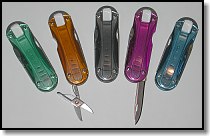 The "Newt" ($22) is Buck's answer to the small Swiss Army Knife with a 1.5 inch pen knife (not locking) and spring loaded scissors, but
no nail file. The stainless frame, 2.625 inches overall, has translucent
acrylic scales in the same range of colors as the rest of the colored Bucks.
The butt end incorporates a large rectangular hole that can be used to attach
it to a key chain, no split ring needed.
The "Newt" ($22) is Buck's answer to the small Swiss Army Knife with a 1.5 inch pen knife (not locking) and spring loaded scissors, but
no nail file. The stainless frame, 2.625 inches overall, has translucent
acrylic scales in the same range of colors as the rest of the colored Bucks.
The butt end incorporates a large rectangular hole that can be used to attach
it to a key chain, no split ring needed.
 In line extensions, Buck has added two new colors, burnt orange and lime green, to their knives having colored anodized handles,
including the diminutive Metro and the Approach. They have downsized the
Approach to come up with the "Short Approach" ($45) having a 2.25 inch
partially serrated 420 HC drop point blade, 3.5 inches closed. The "Mini Alpha
Hunter" ($100) is a small fixed blade with a 2.5 inch drop point ATS-34
stainless blade and rosewood scales. For $240 there's a Custom version with elk
antler scales, filing and mirror polish in a limited edition of 250. The
Folding Alpha Hunter is now available with Walnut scales in the 420HC blade
version with a Cordura sheath ($90).
In line extensions, Buck has added two new colors, burnt orange and lime green, to their knives having colored anodized handles,
including the diminutive Metro and the Approach. They have downsized the
Approach to come up with the "Short Approach" ($45) having a 2.25 inch
partially serrated 420 HC drop point blade, 3.5 inches closed. The "Mini Alpha
Hunter" ($100) is a small fixed blade with a 2.5 inch drop point ATS-34
stainless blade and rosewood scales. For $240 there's a Custom version with elk
antler scales, filing and mirror polish in a limited edition of 250. The
Folding Alpha Hunter is now available with Walnut scales in the 420HC blade
version with a Cordura sheath ($90).
In a reaction to the unfortunate economic realities of trying to run a U.S. based manufacturing business in California, Buck is planning on relocating to Post Falls, Idaho, (near Coeur d'Alene) in 2004.
 The Darrel Ralph� designed "Dominator" ($220) from a
The Darrel Ralph� designed "Dominator" ($220) from a
Opening can be accomplished with the ambidextrous thumb stud or by using the "flipper" incorporated into the blade, which when open forms a substantial guard. You need to press the flipper almost all the way down to the frame for the assisted opening to take place.
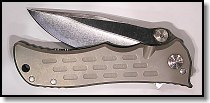 The 3.65 inch long clip point blade is S30V stainless, 0.125 thick, with a tumbled finish. The 4.4 inch long frame is titanium with an integral lock. The machined indents and a satin finish contribute to a better grip, along with ridges for thumb rest and at the butt, top and bottom. There's a lanyard hole and non-reversible, non-ambidextrous pocket clip.� I predict this is going to be a very hot item.� Now, if they'd only make it in a drop point�
The 3.65 inch long clip point blade is S30V stainless, 0.125 thick, with a tumbled finish. The 4.4 inch long frame is titanium with an integral lock. The machined indents and a satin finish contribute to a better grip, along with ridges for thumb rest and at the butt, top and bottom. There's a lanyard hole and non-reversible, non-ambidextrous pocket clip.� I predict this is going to be a very hot item.� Now, if they'd only make it in a drop point�
 Camillus introduced another Becker Knife & Tool blade, the BK10 – "Crewman Utility Knife," ($66) with a 5.5-inch, 0.188 thick blade.� Essentially, Ethan Becker has
shortened a BK7 and given it a much shorter clip point.� It weighs in at 12 oz., pretty reasonable given how robust the knife is. With the exception of a wider hammerhead tang,
as previously used on the BK9 Combat Bowie, it is otherwise identical, including the same tactical sheath shortened to fit the shorter blade.� The wider hammerhead tang will eventually be incorporated into the BK7 as well.
Camillus introduced another Becker Knife & Tool blade, the BK10 – "Crewman Utility Knife," ($66) with a 5.5-inch, 0.188 thick blade.� Essentially, Ethan Becker has
shortened a BK7 and given it a much shorter clip point.� It weighs in at 12 oz., pretty reasonable given how robust the knife is. With the exception of a wider hammerhead tang,
as previously used on the BK9 Combat Bowie, it is otherwise identical, including the same tactical sheath shortened to fit the shorter blade.� The wider hammerhead tang will eventually be incorporated into the BK7 as well.
 Also shown were desert camo versions of the BK7 and BK9 with light tan epoxy coated blades and light tan camo handles (the handle finish actually looks a lot like bird's eye birch), along with a tan sheath.� The sheath would probably be better if all the trim was also tan; with black trim it detracts from the blend-in-with-the-desert-sand look.� If Camillus gets production ramped up quick enough, I expect mom and dad will be sending lots of these over to sons and daughters serving in the Middle East.
Also shown were desert camo versions of the BK7 and BK9 with light tan epoxy coated blades and light tan camo handles (the handle finish actually looks a lot like bird's eye birch), along with a tan sheath.� The sheath would probably be better if all the trim was also tan; with black trim it detracts from the blend-in-with-the-desert-sand look.� If Camillus gets production ramped up quick enough, I expect mom and dad will be sending lots of these over to sons and daughters serving in the Middle East.
 Cold Steel's "Recon 1" line of folders with its Ultralock ambidextrous blade lock ($90) have been refined with deeper textured Zytel handles, for better grip, and subtly restyled blades. Most folks wouldn't notice the difference.
Cold Steel's "Recon 1" line of folders with its Ultralock ambidextrous blade lock ($90) have been refined with deeper textured Zytel handles, for better grip, and subtly restyled blades. Most folks wouldn't notice the difference.
 The lockback "Land & Sea/Rescue" ($75) is back "by popular demand." The 4-inch serrated sheepsfoot blade is AUS 8A. Handles are deeply checkered molded Zytel, 5.062 inches long. There's a lanyard hole, but the pocket clip is non-reversible, non-ambidextrous.
The lockback "Land & Sea/Rescue" ($75) is back "by popular demand." The 4-inch serrated sheepsfoot blade is AUS 8A. Handles are deeply checkered molded Zytel, 5.062 inches long. There's a lanyard hole, but the pocket clip is non-reversible, non-ambidextrous.
A 4-inch 440A stainless black coated tanto blade in plain edge or serrated is now available in the "Pro Lite" line ($70), joining the clip and drop point knives. The liner lock, Zytel handles and oval opening hole remain the same.
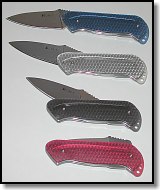 CRK&T� has
introduced an Allen Elishewitz collaboration based on Blackie Collins' Rolox
action, christening it the "Rollock" ($40). Those not familiar with this
mechanism, the knife is opened by first pressing down on the rear of the blade, which pops the point up; then pushing forward slides the blade out and then down into the locked position. The blade has an agressive thumb rest that gives better purchase with which to accomplish this motion. To close, you first release the lock, than pull the blade back into the handle until it locks in place. It is a lot slicker to open than to close.
CRK&T� has
introduced an Allen Elishewitz collaboration based on Blackie Collins' Rolox
action, christening it the "Rollock" ($40). Those not familiar with this
mechanism, the knife is opened by first pressing down on the rear of the blade, which pops the point up; then pushing forward slides the blade out and then down into the locked position. The blade has an agressive thumb rest that gives better purchase with which to accomplish this motion. To close, you first release the lock, than pull the blade back into the handle until it locks in place. It is a lot slicker to open than to close.
The machine turned stainless frame has translucent polycarbonate scales in clear, red, blue or black, which allow you to see how the mechanism works.� It makes for a stunningly contemporary presentation. The polished drop-point blade is AUS 6M stainless, 2.25 inches long, available in plain or combo serrated edge. Closed length is 3.5 inches.� There's a non-reversible, non-ambidextrous skeletonized stainless clip, wide enough to use as a money clip.� A polycarbonate spacer extends out the back of the handle with three holes for a lanyard or split ring.
The Kit Carson designed M16 line is now available in a smaller size, the "Compact EDC" (Every Day Carry) ($70).� The blade is 3 inches of AUS 8 stainless with black titanium nitride coating. It's got all the usual M-16 touches, drilled aluminum handles (in green or black), stainless liner lock, LAWKS safety lock, dual thumb studs, flipper opening that forms an effective guard once open, etc.� The removable pocket clip is still non-reversible, non-ambidextrous. Both a drop point and tanto style blade shape is available in plain or combination edge.� Anyone who likes the M-16 and is looking for a smaller blade will love this one.
 Also downsized, we now have the Michael Walker designed BladeLOCK2, a slightly smaller version of the original with a 3-inch drop point blade in AUS 6M. While somewhat smaller, price remains the same at $80, which makes sense when you figure there's little difference in material cost, it's all in the fabrication and assembly process which isn't any bit easier or quicker with the smaller blade. We prefer the more robust drop point over the original's clip point, even with the false edge that shaves some strength (and weight). The BladeLock combination one-hand opening stud and lock remains the same, locking both open and closed, but it is not ambidextrous.
Also downsized, we now have the Michael Walker designed BladeLOCK2, a slightly smaller version of the original with a 3-inch drop point blade in AUS 6M. While somewhat smaller, price remains the same at $80, which makes sense when you figure there's little difference in material cost, it's all in the fabrication and assembly process which isn't any bit easier or quicker with the smaller blade. We prefer the more robust drop point over the original's clip point, even with the false edge that shaves some strength (and weight). The BladeLock combination one-hand opening stud and lock remains the same, locking both open and closed, but it is not ambidextrous.
The blade has a nice thumb rest at the base. The stainless frame has molded textured Zytel scales with a non-reversible, non-ambidextrous stainless pocket clip. There is no lanyard hole.
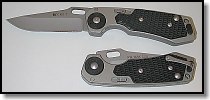 Let the D.O.G. out? Grant Hawk's D.O.G. (Deadbolt Over Grabstep) lock design provides both moniker and ambidextrous lock release for this new "Hawk D.O.G." folder by CRK&T ($100). The locking mechanism will remind some of the original Blackie Collins designed Gerber bolt action lock, except it also locks closed. In this iteration, it is a sealed design, keeping dirt out of the spring and rod assembly, which is a good thing, and it is claimed will lock up even if the blade doesn't quite hit the stop. It is also ambidextrous, which we prefer.
Let the D.O.G. out? Grant Hawk's D.O.G. (Deadbolt Over Grabstep) lock design provides both moniker and ambidextrous lock release for this new "Hawk D.O.G." folder by CRK&T ($100). The locking mechanism will remind some of the original Blackie Collins designed Gerber bolt action lock, except it also locks closed. In this iteration, it is a sealed design, keeping dirt out of the spring and rod assembly, which is a good thing, and it is claimed will lock up even if the blade doesn't quite hit the stop. It is also ambidextrous, which we prefer.
 The 3.5 inch long clip point blade is of AUS 8 stainless with a rectangular oval opening hole and thumb rest at the base. You can chose plain edge or a combination edge. There is a good size integral guard in the handle. The aluminum frame comes with two sets of Zytel scales, held on with Torx fasteners; one checkered, the other diagonally fluted.� The reversible pocket clip is unique in design as well and is pretty short.� It is mounted very near the top of the handle, which is nice.� We'll reserve judgment on how well the short clip works until after we try it. There's also a lanyard hole. With the moveable ambidextrous pocket clip, opening hole and bolt lock design, the knife is completely ambidextrous.
The 3.5 inch long clip point blade is of AUS 8 stainless with a rectangular oval opening hole and thumb rest at the base. You can chose plain edge or a combination edge. There is a good size integral guard in the handle. The aluminum frame comes with two sets of Zytel scales, held on with Torx fasteners; one checkered, the other diagonally fluted.� The reversible pocket clip is unique in design as well and is pretty short.� It is mounted very near the top of the handle, which is nice.� We'll reserve judgment on how well the short clip works until after we try it. There's also a lanyard hole. With the moveable ambidextrous pocket clip, opening hole and bolt lock design, the knife is completely ambidextrous.
 The "Lake Signature" folder has aluminum frame handles with inlaid drilled Zytel inserts.� There's a titanium liner lock and a new operating mechanism for the LAWKS safety lock. Instead of a stud at the base of the blade, the lock is operated by a lever formed by the pocket clip. We'll see how practical this is in everyday use. The clip point blade, plain or combination edge, is AUS 8 stainless, 3.25 inches long, with a pair of opposed oversize nail nicks for ambidextrous one-hand opening. The back spacer is Zytel with a cut-out for lanyard attachment.
The "Lake Signature" folder has aluminum frame handles with inlaid drilled Zytel inserts.� There's a titanium liner lock and a new operating mechanism for the LAWKS safety lock. Instead of a stud at the base of the blade, the lock is operated by a lever formed by the pocket clip. We'll see how practical this is in everyday use. The clip point blade, plain or combination edge, is AUS 8 stainless, 3.25 inches long, with a pair of opposed oversize nail nicks for ambidextrous one-hand opening. The back spacer is Zytel with a cut-out for lanyard attachment.
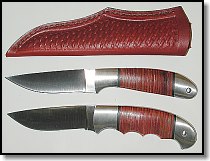 The "Alaskan Pro Hunter" series ($150) are traditional fixed blades with tooled leather slip sheaths. Three blade shapes are offered, the "Chugach Range" with a modified drop point, the "Wrangle Range" with a classic drop point and the "Brooks Range" with a semi-skinner blade shape. The full tang AUS 8 blades, 3.25 inches long and 0.16 inches thick, are equipped with a stainless bolster and butt cap.� A hollow rivet also serves as a lanyard hole. The oval shaped handles are stacked dyed leather.� The Wrangell Range is equipped with four finger grooves, the others are smooth.� All have a mild integral front guard formed by the bolster and the Wrangle Range also has a rear finger hook incorporated into the butt.�
The "Alaskan Pro Hunter" series ($150) are traditional fixed blades with tooled leather slip sheaths. Three blade shapes are offered, the "Chugach Range" with a modified drop point, the "Wrangle Range" with a classic drop point and the "Brooks Range" with a semi-skinner blade shape. The full tang AUS 8 blades, 3.25 inches long and 0.16 inches thick, are equipped with a stainless bolster and butt cap.� A hollow rivet also serves as a lanyard hole. The oval shaped handles are stacked dyed leather.� The Wrangell Range is equipped with four finger grooves, the others are smooth.� All have a mild integral front guard formed by the bolster and the Wrangle Range also has a rear finger hook incorporated into the butt.�
 The "M18K" is now available in subdued dress with black blades and black frames with black or green inserts ($110 and $120). The "M16" is now available in a "Titanium" model that incorporates a bead-blasted titanium frame handles. Offered with a 3.94 inch modified tanto blade ($150) or a 3.56 inch spear point blade ($125), both with combination edge.
The "M18K" is now available in subdued dress with black blades and black frames with black or green inserts ($110 and $120). The "M16" is now available in a "Titanium" model that incorporates a bead-blasted titanium frame handles. Offered with a 3.94 inch modified tanto blade ($150) or a 3.56 inch spear point blade ($125), both with combination edge.
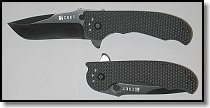 Greg Lightfoot's new "Lightfoot M1" ($70) is a tactical with a lot of utility, missing only a single critical ingredient. The AUS 8 stainless blade (titanium nitride coated) is shaped a bit different, something of a tanto configuration, but in curves. The recurved hollow ground blade has a high tip and a false edge, but there's no clip and it still carries a lot of meat to the point. The blade is available with plain or combination edge. Ambidextrous thumbs studs and a flipper opener provide easy opening.
Greg Lightfoot's new "Lightfoot M1" ($70) is a tactical with a lot of utility, missing only a single critical ingredient. The AUS 8 stainless blade (titanium nitride coated) is shaped a bit different, something of a tanto configuration, but in curves. The recurved hollow ground blade has a high tip and a false edge, but there's no clip and it still carries a lot of meat to the point. The blade is available with plain or combination edge. Ambidextrous thumbs studs and a flipper opener provide easy opening.
The stainless frame includes the liner lock, and there's the usual CRK&T LAWKS safety. Molded Zytel scales have an agressive pattern. The flipper opener provides a very good guard and when combined with the ribbed thumb ramp and scallops in the handle, a good safe grip is assured. The wide "paddle" pocket clip is ambidextrous and reversible, but there's no lanyard hole!
The K.I.S.S. line of folders now come in all black, "K.I.S.S. In The Dark" and "P.E.C.K. In The Dark" and in "Black Gold" models in black and with gold plated fasteners and clips, a striking combination.
 Chris Reeve didn't have any brand new knife designs, but there was plenty of interest in "The Yarborough" or "Green Beret Knife" introduced late last year.� Chris advised they had sold about 1000 to date. This was my first opportunity to handle one and it's easy to see why the Green Berets settled on this Bill Harsey design, well executed by Reeve.� The 7-inch spearpoint blade of S30V stainless with OD black canvas Micarta handles just plain feels good.� This one can be yours, in a non-serialized version and less the Yarborough stamp on the blade, for $299 with a Blackhawk sheath.
Chris Reeve didn't have any brand new knife designs, but there was plenty of interest in "The Yarborough" or "Green Beret Knife" introduced late last year.� Chris advised they had sold about 1000 to date. This was my first opportunity to handle one and it's easy to see why the Green Berets settled on this Bill Harsey design, well executed by Reeve.� The 7-inch spearpoint blade of S30V stainless with OD black canvas Micarta handles just plain feels good.� This one can be yours, in a non-serialized version and less the Yarborough stamp on the blade, for $299 with a Blackhawk sheath.
 We also had the opportunity to play with the "Nkona" ($325), the latest addition to the One Piece Range.� The major difference is that the integral hollow handle is fitted with
an innovative tool kit that provides an integral screwdriver in the butt cap with a choice of six 1/4 hex bits held in an aluminum bit holder. Unfortunately, the screwdriver cannot be retrofitted to his earlier knife designs, it just won't fit.� As such, we hope Chris eventually either makes changes to others in the One Piece Range to accommodate the screwdriver kit or introduces some more conventional blade styles to this variation, as the straight-backed blade isn't one of our favorites, though we did like its dual beveled spine.
We also had the opportunity to play with the "Nkona" ($325), the latest addition to the One Piece Range.� The major difference is that the integral hollow handle is fitted with
an innovative tool kit that provides an integral screwdriver in the butt cap with a choice of six 1/4 hex bits held in an aluminum bit holder. Unfortunately, the screwdriver cannot be retrofitted to his earlier knife designs, it just won't fit.� As such, we hope Chris eventually either makes changes to others in the One Piece Range to accommodate the screwdriver kit or introduces some more conventional blade styles to this variation, as the straight-backed blade isn't one of our favorites, though we did like its dual beveled spine.
 The Nkonka sports a 7.5 inch blade of D2 with Reeve's Kalguard finish. A "numbered collectable" version in CPM 3V steel is also available ($445).� The dual guard
enhanced with titanium finials.� The ball also serves to better secure the knife in its special leather sheath, slipping into a "slit-cam" cut in the spine.��
The Nkonka sports a 7.5 inch blade of D2 with Reeve's Kalguard finish. A "numbered collectable" version in CPM 3V steel is also available ($445).� The dual guard
enhanced with titanium finials.� The ball also serves to better secure the knife in its special leather sheath, slipping into a "slit-cam" cut in the spine.��
For those so inclined, Chris has also introduced a new range of standard decorations for the Sebenza line. The small Uumfam integral lock folder is gone (sigh, missed that chance...procrastination is not pretty), having been entirely superceded by the more elegant Mnandi.
 The biggest news from Ernest Emerson was the introduction of his "Hard Wear" line of "under $100" lockback folders produced in Japan. There are three knives identical material specifications. Handles are molded black Zytel with what they are calling "aqua tread grip pattern." The very deep integral guard is provided, along with thumb rest and ramp on top of the handle and blade.� The handle shape mimics that of the Commander. The pocket clip is non-reversible, non-ambidextrous and there's a lanyard hole. Opening is via a large triangular oval hole in the blade, which is AUS 8 stainless with a satin finish. Initial production will be partially serrated; eventually plain edge and fully serrated are anticipated.
The biggest news from Ernest Emerson was the introduction of his "Hard Wear" line of "under $100" lockback folders produced in Japan. There are three knives identical material specifications. Handles are molded black Zytel with what they are calling "aqua tread grip pattern." The very deep integral guard is provided, along with thumb rest and ramp on top of the handle and blade.� The handle shape mimics that of the Commander. The pocket clip is non-reversible, non-ambidextrous and there's a lanyard hole. Opening is via a large triangular oval hole in the blade, which is AUS 8 stainless with a satin finish. Initial production will be partially serrated; eventually plain edge and fully serrated are anticipated.
The two larger knives, the "Reliant" and "Endeavor," have a 3.4-inch blade, tanto and clip point, respectively. Overall length is 7.9 inches. The smaller "Taveler" has a 3 inch blade, 7 inches overall.
The liner lock "Nova" is termed a "sport utility knife" and features a 3.5-inch clip point blade of 154 CM stainless, satin or black Teflon coated, partially serrated with a thumb disk opener and thumb ramp. The 4.75 inch long handle is of "C-10/Glass Laminate" scales over a stainless frame and has a deep guard and two large finger scallops, along with the requisite lanyard hole.
 The "Fusion" is a new Alan Elishewitz designed folder with a deep drop point 3.35 inch blade of 154 CM stainless. Opening is via ambidextrous thumb studs.� The frame is stainless, along with the liner lock. The black G-10 scales don't cover the entire frame, especially as the butt end, giving it a unique look. There's a wide shallow finger choil behind the conventional choil and a deep recess for the rest of the fingers in the 4.35 inch long handle. There's a pocket clip and lanyard hole.
The "Fusion" is a new Alan Elishewitz designed folder with a deep drop point 3.35 inch blade of 154 CM stainless. Opening is via ambidextrous thumb studs.� The frame is stainless, along with the liner lock. The black G-10 scales don't cover the entire frame, especially as the butt end, giving it a unique look. There's a wide shallow finger choil behind the conventional choil and a deep recess for the rest of the fingers in the 4.35 inch long handle. There's a pocket clip and lanyard hole.
 Gerber has long been the favorite of those desiring quick one-hand deploying pliers with their original 600 and smaller 400 series of Multi-Pliers, the pliers slipping out of the handles with a flick of the wrist. Now they've gone the next step with the spring-loaded "Recoil Auto-Plier" ($62). Shift the safety lock from "SAFE" to "READY," press the gold-colored button and out pop the spring-loaded needlenose pliers jaws.� It's pretty slick! On the down side, the springs necessary to accomplish this trick take up most of the handle space.
Gerber has long been the favorite of those desiring quick one-hand deploying pliers with their original 600 and smaller 400 series of Multi-Pliers, the pliers slipping out of the handles with a flick of the wrist. Now they've gone the next step with the spring-loaded "Recoil Auto-Plier" ($62). Shift the safety lock from "SAFE" to "READY," press the gold-colored button and out pop the spring-loaded needlenose pliers jaws.� It's pretty slick! On the down side, the springs necessary to accomplish this trick take up most of the handle space.
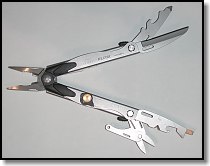 The locking tools and blade open out from the tool handles and all all offset to one side because of the space needed for the springs. The lack of space has forced Gerber to combine tools into a pair of multi-purpose implements. One handle contains one-hand-opening "Fiskars" scissors (Fiskars owns Gerber) and the multi-purpose implement incorporating a can opener, flat screwdrive and vee style wire stripper. The other handle holds a plain edge warncliff style one-hand-opening blade and a multi-purpose implement with a cap lifter, Phillips screwdriver and twine cutter. The latter is essentially a miniature line cutter, of questionable practicality in our opinion, but only testing will tell.� There's a plastic lock release that protrudes through a hole in each handle.
The locking tools and blade open out from the tool handles and all all offset to one side because of the space needed for the springs. The lack of space has forced Gerber to combine tools into a pair of multi-purpose implements. One handle contains one-hand-opening "Fiskars" scissors (Fiskars owns Gerber) and the multi-purpose implement incorporating a can opener, flat screwdrive and vee style wire stripper. The other handle holds a plain edge warncliff style one-hand-opening blade and a multi-purpose implement with a cap lifter, Phillips screwdriver and twine cutter. The latter is essentially a miniature line cutter, of questionable practicality in our opinion, but only testing will tell.� There's a plastic lock release that protrudes through a hole in each handle.
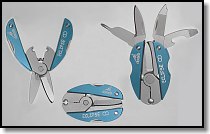 Gerber has entered the micro-tool market with the "Total Eclipse" (no price provided) a keychain tool with spring-loaded scissors as the primary implement. The anodized blue aluminum handles rotate back to allow the scissors
to open, with spring loaded balls holding them in place. They are held in places with ball detents. Opening out from inside the
handles are a small drop point blade, #0 Phillips screwdriver, crosscut
file/nail cleaner and a cap lifter with medium flat screwdriver.
Gerber has entered the micro-tool market with the "Total Eclipse" (no price provided) a keychain tool with spring-loaded scissors as the primary implement. The anodized blue aluminum handles rotate back to allow the scissors
to open, with spring loaded balls holding them in place. They are held in places with ball detents. Opening out from inside the
handles are a small drop point blade, #0 Phillips screwdriver, crosscut
file/nail cleaner and a cap lifter with medium flat screwdriver.
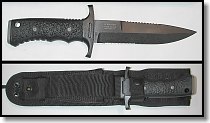 The Bill Harsey designed "Silver Trident" ($340) was designed as a combat-ready knife that would also be suitable for survival use. It sports a 6-inch modified drop point (nearly spear point) blade of 154 CM stainless. It is available with or without a saw back on the blade spine and is partly serrated along the cutting edge.
The Bill Harsey designed "Silver Trident" ($340) was designed as a combat-ready knife that would also be suitable for survival use. It sports a 6-inch modified drop point (nearly spear point) blade of 154 CM stainless. It is available with or without a saw back on the blade spine and is partly serrated along the cutting edge.
The Hytrel rubber handle encapsulates the nearly full tang with three finger scallops along the bottom. There is a large double guard of the same material.� A solid stainless butt cap is provided for use as a hammer and it is retained by the handle material, not connected directly to the blade to eliminate any shock transfer. Bill Harsey explained the handle material choice and assembly process for us, the Hytrel is "done in a two stage plastic injection molding process. The core including the guard area is high strength Hytrel that will hold high toughness down to negative 40 degrees F. This means even at that temp we can (and have) hammered on the handle and it won't crack. Hytrel is used on snow ski pole baskets for this same reason. It seems to defy tearing of any kind. This is why I choose this plastic for this handle. The overmolded (outside of handle) Hytrel is slightly softer durometer for better gripping."
A Blackhawk tactical sheath is provided.
Gerber presented a number of other new blades, including the "Harsey X Frame," "Paraframe I," Paraframe II" and "Mini Paraframe," "AR 3.25 Lockback," "Vector" and "Freeman Hunter" that we'd love to tell you more about, but they provided no useful specifications or information in the press packet and even three weeks after SHOT Show was over we were told by the new PR guy that getting us the information we requested so that we could properly present these knives to you was "not (their) highest priority." If they eventually get around to it, we'll add mroe information about the rest of the new knives.
If that bothers you, the new PR guy's name is Mark Schindel and you can email him at [email protected] (and you might want to copy Chad Vincent, President of Gerber, at [email protected]) or call Mark at 800-777-6805 extension 231. Perhaps if enough contact him (PLEASE--Be Polite, even if he isn't!) he'll appreciate that even if we don't publish a glossy magazine where they sepnd lots of money to vget good press, perhaps we're still a useful outlet for information about their products with a loyal following.
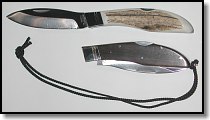 If you like the unique blade of the Canadian built Grohmann fixed blades, but wish it were available in a folder, your wish has been fulfilled. The "D. H. Russell Lockback"�
($149)� has a 3.75-inch blade that duplicates that of the #1 Original with a closed length of 5 inches. The base handle has nickel silver bolsters and rosewood scales.� Other scales choices include "Xtra resinwood"� and Micarta ($148) or water buffalo horn ($184).� It comes with an attached wrist lanyard and a leather belt sheath.� Now, if they'd just add one-handed opening...
If you like the unique blade of the Canadian built Grohmann fixed blades, but wish it were available in a folder, your wish has been fulfilled. The "D. H. Russell Lockback"�
($149)� has a 3.75-inch blade that duplicates that of the #1 Original with a closed length of 5 inches. The base handle has nickel silver bolsters and rosewood scales.� Other scales choices include "Xtra resinwood"� and Micarta ($148) or water buffalo horn ($184).� It comes with an attached wrist lanyard and a leather belt sheath.� Now, if they'd just add one-handed opening...
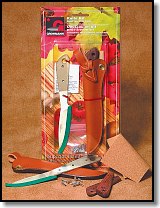 The fixed blade knives are also now available with a flat grind option at no additional cost for those who prefer that style.
The fixed blade knives are also now available with a flat grind option at no additional cost for those who prefer that style.
Grohmann is also offering "You-Make-It" knife kits that cover virtually the entire line of fixed blades.� The provided blade is already sharpened, all you really have to do is assemble the handle and slip the finished blade into the provided leather sheath. Savings run 25 percent for some of your time and a chance for some pride of personal craftsmanship. As an example, the Survival is $71 while the completed knife is $95.
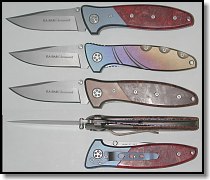 KA-BAR is importing and distributing Tecnocut knives from Italy and there were some beautiful liner lock folders. The "Side Lock"" folders are equipped with 3 inch clip point blades of Sandvik 12C27 stainless fitted with ambidextrous thumb studs. The liners are anodized titanium with some beautiful ersatz file work on two, while the back spacer is similarly worked on the third. Handles are 4.25 inches long and come fitted with scales in three versions, red stabilized maple burl with blue anodized titanium bolsters (KT 2610 $191), brown stabilized maple burl with brown anodized titanium bolsters (KT2611 $203) and a solid rainbow anodized titanum (KT 2612 $180).
KA-BAR is importing and distributing Tecnocut knives from Italy and there were some beautiful liner lock folders. The "Side Lock"" folders are equipped with 3 inch clip point blades of Sandvik 12C27 stainless fitted with ambidextrous thumb studs. The liners are anodized titanium with some beautiful ersatz file work on two, while the back spacer is similarly worked on the third. Handles are 4.25 inches long and come fitted with scales in three versions, red stabilized maple burl with blue anodized titanium bolsters (KT 2610 $191), brown stabilized maple burl with brown anodized titanium bolsters (KT2611 $203) and a solid rainbow anodized titanum (KT 2612 $180).
The handle incorporates a deep guard and the one with solid titanium scales is also equipped with a machined thumb rest on top, the others' are smooth. A removeable skeletonized pocket clip is fitted and they all have lanyard holes.
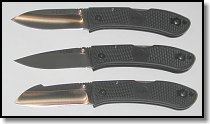 KA-BAR introduced a trio of Taiwanese made lockback folders to their Precision Hunter lineup ($28), the folders a collaboration with Bob Dozier. The 3-inch blades are AUS 8 stainless in drop point, clip point and skinner shapes. They have a right hand opening thumb stud. 4.24 inch long handle is Zytel with virtually no guard. The metal pocket clip is fixed in place and there is a lanyard hole.
KA-BAR introduced a trio of Taiwanese made lockback folders to their Precision Hunter lineup ($28), the folders a collaboration with Bob Dozier. The 3-inch blades are AUS 8 stainless in drop point, clip point and skinner shapes. They have a right hand opening thumb stud. 4.24 inch long handle is Zytel with virtually no guard. The metal pocket clip is fixed in place and there is a lanyard hole.
 KA-BAR also presented a pair of machetes ($56), also made in Taiwan, with 1085 carbon steel blades and Kraton handles. The large blades are "Cutlass" and "Kukri" shaped, 11 and 11.5 inches long, respectively, with 5.5 inch long handles and including a lanyard hole. They weigh in at 1.12 and 1.26 pounds, respectively, not including the sheath. A black leather and Cordura sheath is included.
KA-BAR also presented a pair of machetes ($56), also made in Taiwan, with 1085 carbon steel blades and Kraton handles. The large blades are "Cutlass" and "Kukri" shaped, 11 and 11.5 inches long, respectively, with 5.5 inch long handles and including a lanyard hole. They weigh in at 1.12 and 1.26 pounds, respectively, not including the sheath. A black leather and Cordura sheath is included.
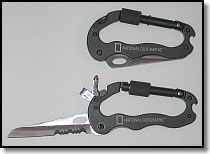 Kershaw's "National Geographic Tool" ($60) is a carabiner based tool licensed to use the Society's name. The 3.24-inch AUS 6A stainless sheepsfoot blade is retained in the backside of the carabiner style aluminum frame.� It has an oval opening hole with a combination edge and liner lock. The non-load bearing carabiner, 4.126 inches overall length, also hides folding flat and Phillips screwdrivers and has an integral bottle cap lifter. The spring-loaded carabiner gate has a rotary screw type lock. While relatively comfortable to grip, our initial
impression was that it is too gimmicky, but then we're pretty conservative types.
Kershaw's "National Geographic Tool" ($60) is a carabiner based tool licensed to use the Society's name. The 3.24-inch AUS 6A stainless sheepsfoot blade is retained in the backside of the carabiner style aluminum frame.� It has an oval opening hole with a combination edge and liner lock. The non-load bearing carabiner, 4.126 inches overall length, also hides folding flat and Phillips screwdrivers and has an integral bottle cap lifter. The spring-loaded carabiner gate has a rotary screw type lock. While relatively comfortable to grip, our initial
impression was that it is too gimmicky, but then we're pretty conservative types.
 The unique terraced blue anodized titanium scales of the "Sapphire" ($100) make it a striking folder.� Four inches overall, with a 3-inch AUS8A spearpoint blade, it uses a stainless liner lock, has a thumb stud for one-hand opening and a removable non-ambidextrous, non-reversible pocket clip, but no lanyard hole.
The unique terraced blue anodized titanium scales of the "Sapphire" ($100) make it a striking folder.� Four inches overall, with a 3-inch AUS8A spearpoint blade, it uses a stainless liner lock, has a thumb stud for one-hand opening and a removable non-ambidextrous, non-reversible pocket clip, but no lanyard hole.
 The "LFK" (Little Folding Knife) is a small, lightweight (1.1 oz.) liner lock folder with aluminum scales, anodized matte black and at a lightweight price, $25. The modified drop point blade is AUS 8A with thumb stud opener. No pocket clip or lanyard hole.
The "LFK" (Little Folding Knife) is a small, lightweight (1.1 oz.) liner lock folder with aluminum scales, anodized matte black and at a lightweight price, $25. The modified drop point blade is AUS 8A with thumb stud opener. No pocket clip or lanyard hole.
 Kershaw's "Steven Segal" folder ($150) is a collaboration between the action film star and knifemaker Ken Onion. The ground portion of the blade has Segal's signature in English on one side and in Japanese on the other. The anodized black 5-inch aluminum scales have black natural stingray leather inserts, which are pretty grippy, as you might expect.� The blade shape is unique with 3.625 inches of recurved edge, almost a skinner shape tip, and a long swept clip.� The AUS8A stainless blade is available plain or with a short serrated section at the base of the blade.� The choil, such as it is, falls under the forward end of the handle, thus the cutting edge covers the entire useable length of the blade.
Kershaw's "Steven Segal" folder ($150) is a collaboration between the action film star and knifemaker Ken Onion. The ground portion of the blade has Segal's signature in English on one side and in Japanese on the other. The anodized black 5-inch aluminum scales have black natural stingray leather inserts, which are pretty grippy, as you might expect.� The blade shape is unique with 3.625 inches of recurved edge, almost a skinner shape tip, and a long swept clip.� The AUS8A stainless blade is available plain or with a short serrated section at the base of the blade.� The choil, such as it is, falls under the forward end of the handle, thus the cutting edge covers the entire useable length of the blade.
The ergonomic handle incorporates a deep integral guard that also accommodates the liner lock release and a thumb rest at the top of the handle. At the butt end, a ridged pincy lip and butt provide additional security. The skeletonized pocket clip is reversible. Somewhat inexplicably for an otherwise practical utility/tactical knife, there's no lanyard hole, but we were told that, "adding a lanyard hole messed with the lines of the knife. Neither Ken Onion or Steven Segal felt it was necessary."����
 Kershaw has joined the folding saw brigade with their appropriately named model 2550 "Folding Saw" ($30).� It has a 7-inch aggressive wood blade of "Swedish saw steel" powder coated black and molded Santoprene rubber handles, 16 inches overall when open, 9 inches closed. There's a push-button lock to both open and close the blade. A lanyard hole is provided, but no belt sheath is available.
Kershaw has joined the folding saw brigade with their appropriately named model 2550 "Folding Saw" ($30).� It has a 7-inch aggressive wood blade of "Swedish saw steel" powder coated black and molded Santoprene rubber handles, 16 inches overall when open, 9 inches closed. There's a push-button lock to both open and close the blade. A lanyard hole is provided, but no belt sheath is available.
�
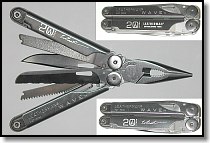 For the first time in years, Leatherman had no real new products to introduce. Their big news was a 20th anniversary edition of the Wave, celebrating 20 years since Tim Leatherman started the company that
created a new category of multi-function tools. There are really two versions of
this anniversary edition Wave, the more commonplace version and an even rarer edition with Tim's signature, limited to 500 serial numbered units.
For the first time in years, Leatherman had no real new products to introduce. Their big news was a 20th anniversary edition of the Wave, celebrating 20 years since Tim Leatherman started the company that
created a new category of multi-function tools. There are really two versions of
this anniversary edition Wave, the more commonplace version and an even rarer edition with Tim's signature, limited to 500 serial numbered units.
For the standard anniversary edition, the Wave frame receives a black chromium oxide plating. The bolsters and the pin/screw sets are coated in black nickel.� The signed addition also gets black Tungsten DLC (Diamond-Like Carbon) coated pliers, blades, saw and even the file.� The 20th Anniversary logo and Tim's signature are laser engraved into the frame, the stainless contrasting sharply against the black coating.� It looks sharp and I doubt very many of these will actually see any use.
�The standard anniversary edition is limited to orders in hand on March 31st with delivery starting July 1 and priced the same as the standard Wave, though street price is still an open question. Collectors get your orders in to authorized Leatherman dealers now.� No distribution decision has been made with regards the even more limited signature edition Waves, other than they will be distributed direct from the
factory.��
Lone Wolf knives has come into its own in the past year and these Gerber refugees, unhappy with the direction Fiskars was taking the company, seem to have done a heck of a job of quickly developing an increasingly impressive line of higher end production and limited production knives.
 This seems to be a Bill Harsey year, with knives from three different manufacturers in this review.� Lone Wolf's large "Harsey Tactical Folder" ($289) represents his take on
the subject. The modified drop point blade of S30V stainless is 4.75 inches
long, 0.17 inches thick, with a long false edge on the spine, for obvious
tactical reasons. Opening is via ambidextrous thumb studs. The titanium locking
liner is also equipped with an Action Lock safety. The titanium frame is
covered with black canvas Micarta scales.� There's a non-reversible, non-ambidextrous titanium pocket clip.
This seems to be a Bill Harsey year, with knives from three different manufacturers in this review.� Lone Wolf's large "Harsey Tactical Folder" ($289) represents his take on
the subject. The modified drop point blade of S30V stainless is 4.75 inches
long, 0.17 inches thick, with a long false edge on the spine, for obvious
tactical reasons. Opening is via ambidextrous thumb studs. The titanium locking
liner is also equipped with an Action Lock safety. The titanium frame is
covered with black canvas Micarta scales.� There's a non-reversible, non-ambidextrous titanium pocket clip.
Action of the prototype we handled was silky smooth, which was true for all the Lone Wolf folders, so hopefully it will carry through to production.� The large handle, 5.9� inches, has a deep integral guard with a second finger indent and ridges on both the bottom end and top fore end, along with a thumb ramp on the back spine of the blade.� The butt has an ergonomic curved to it, with a lanyard hole.� The open frame makes for easy cleaning.
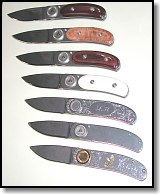 Lovers of the "Paul Pocket Knife," and its unique axial locking mechanism, will be doing flips over the variety offered up by Lone Wolf. All have 2-inch highly polished 420HC blades and a stainless frame. Closed length is 3.12 inches. No pocket clip or lanyard hole.
Lovers of the "Paul Pocket Knife," and its unique axial locking mechanism, will be doing flips over the variety offered up by Lone Wolf. All have 2-inch highly polished 420HC blades and a stainless frame. Closed length is 3.12 inches. No pocket clip or lanyard hole.
Offerings range from the basic unadorned stainless version ($130) through engraved ($150) and on to a variety of scales material including ivory Micarta, wine Micarta, burl wood, rosewood (all $150), thence to Jade scales with 24K gold plated fittings and lock pieces ($180).� Ratcheting it up another notch is the "Signature Series ($200) with carbom fiber scales inlaid with an ivory Micarta insert engraved with Paul Poehlmann's signature and 24K gold plated fittings and lock mechanism.� Not enough for you?� How about a raindrop pattern stainless steel damascus steel blade with red Amboyna burl scales and 24K gold fittings and lock mechanism ($300)?�� All come in a metal gift box with a leather pocket sheath.
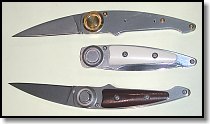 Also new is the "Paul Perfecto Knife" ($140), which takes the same locking mechanism and materials and then pares down everything around it to a very slim package with a 2.25 inch wharncliff blade, 3.12 inches closed. Available in stainless or with ivory or wine Micarta scales.
Also new is the "Paul Perfecto Knife" ($140), which takes the same locking mechanism and materials and then pares down everything around it to a very slim package with a 2.25 inch wharncliff blade, 3.12 inches closed. Available in stainless or with ivory or wine Micarta scales.
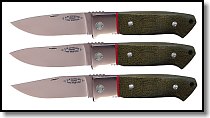 A trio of "Loveless Traditional" folders ($200) with 3.25
inch blades, 0.125 inches thick, of LV-02 are mirror images for the most part
of Loveless' classic fixed blades with forged stainless bolsters and frame and
a stainless liner lock mechanism. Green Micarta scales with a red "spacer" are
affixed with stainless hardware. The blade has a nail nick for opening, in
keeping with the traditional look and feel, and there's a flat ridged thumb
rest at the base of the spine. The 4.24 inch handle is the classic Loveless
shape with traditional guard at front and a pinkie hook at the butt, plus the
requisite lanyard hole. There's no pocket clip.� Available in three blade styles: "Drop Point," "Utility" and
"Semi-Skinner."�
A trio of "Loveless Traditional" folders ($200) with 3.25
inch blades, 0.125 inches thick, of LV-02 are mirror images for the most part
of Loveless' classic fixed blades with forged stainless bolsters and frame and
a stainless liner lock mechanism. Green Micarta scales with a red "spacer" are
affixed with stainless hardware. The blade has a nail nick for opening, in
keeping with the traditional look and feel, and there's a flat ridged thumb
rest at the base of the spine. The 4.24 inch handle is the classic Loveless
shape with traditional guard at front and a pinkie hook at the butt, plus the
requisite lanyard hole. There's no pocket clip.� Available in three blade styles: "Drop Point," "Utility" and
"Semi-Skinner."�
 Lone Wolf's lone fixed blade line comprise a pair of classic R.W. Loveless designs, aptly named the "Loveless Classic Utility" and "Loveless Classic Semi-Skinner," both $190.� There's currently no Drop Point, the most classic of the Loveless designs, but that could change now that Gerber's deal to produce that fixed blade style has expired. Blades are 4.5 and 3.75 inches, respectively, forged in one piece with the tang and guard of LV-04 stainless. Scales are green
Micarta with red spacer and stainless rivets. Overall length is 9.25 and 8.5
inches, respectively.
Lone Wolf's lone fixed blade line comprise a pair of classic R.W. Loveless designs, aptly named the "Loveless Classic Utility" and "Loveless Classic Semi-Skinner," both $190.� There's currently no Drop Point, the most classic of the Loveless designs, but that could change now that Gerber's deal to produce that fixed blade style has expired. Blades are 4.5 and 3.75 inches, respectively, forged in one piece with the tang and guard of LV-04 stainless. Scales are green
Micarta with red spacer and stainless rivets. Overall length is 9.25 and 8.5
inches, respectively.
All the above Loveless knives come with a leather belt sheath and zippered storage pouch.
![]() Lone Wolf also offers what they claim is the "first pocket knife designed by R.W. Loveless in over 20 years," the "R.W. Loveless City Knife" ($100). It features a 2.6 inch modified wharncliff blade of LV-03 stainless. The stainless bolster, red spacer and green micarta scales are the same as the larger Traditional folders, with a 3.31-inch long straight handle with no guard. There's no pocket clip, but there is a lanyard hole. A leather pocket sheath and zippered pouch is included.
Lone Wolf also offers what they claim is the "first pocket knife designed by R.W. Loveless in over 20 years," the "R.W. Loveless City Knife" ($100). It features a 2.6 inch modified wharncliff blade of LV-03 stainless. The stainless bolster, red spacer and green micarta scales are the same as the larger Traditional folders, with a 3.31-inch long straight handle with no guard. There's no pocket clip, but there is a lanyard hole. A leather pocket sheath and zippered pouch is included.
Of the peculiar "LV" designation steels used in the Loveless knives, said Lone Wolf, "you have probably noticed that some of the steels used in our products are not listed on common blade steel charts.� These new blade steels have been developed for our products by working closely with several major steel producers to develop proprietary steels based on modifying the chemistry of their better blade steels."� For more information, including a steel composition chart, click here (PDF format - opens a new browser window).
 The "Marble's Safety Axe" is back.� Now outfitted with a composition handle, it retains Marble's unique integral folding safety cover, also now composition, that folds into the handle when you need to use the axe. The head is forged high carbon steel, 20
oz. with a 2.75-inch long cutting edge.� Overall length is 11.5 inches and the handle is textured on the lower portion for a more secure better grip. We have always admired the elegant
simplicity of the original Marble's Safety Axes that formed the foundation of the original company and it's nice to see them introduce an updated version.� Price was estimated to be
"under $50."
The "Marble's Safety Axe" is back.� Now outfitted with a composition handle, it retains Marble's unique integral folding safety cover, also now composition, that folds into the handle when you need to use the axe. The head is forged high carbon steel, 20
oz. with a 2.75-inch long cutting edge.� Overall length is 11.5 inches and the handle is textured on the lower portion for a more secure better grip. We have always admired the elegant
simplicity of the original Marble's Safety Axes that formed the foundation of the original company and it's nice to see them introduce an updated version.� Price was estimated to be
"under $50."
Marble's also introduced an inexpensive line of flat ground 420HC stainless knives with molded rubber handles, their "Safe Grip" series, estimated price of "under $35" and made in the U.S.
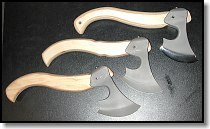 McGowan introduced a pair of more affordable versions of its FireStone Belt Axe (top on right), the "FireStone Utility Axe" (middle on right) and the "FireStone Carving Axe" (bottom on right), both with a $100 price tag. These are made of the same materials at the original, investment cast head and laminated wood handle, just not as finely finished, or as they put it, in an "industrial finish." Both come with a leather belt sheath.
McGowan introduced a pair of more affordable versions of its FireStone Belt Axe (top on right), the "FireStone Utility Axe" (middle on right) and the "FireStone Carving Axe" (bottom on right), both with a $100 price tag. These are made of the same materials at the original, investment cast head and laminated wood handle, just not as finely finished, or as they put it, in an "industrial finish." Both come with a leather belt sheath.
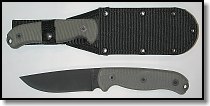 Ontario introduced a new fixed blade collaboration with Randall's Adventure & Training (RAT), the "TAK" ($80), following on the success of last year's RTAK. This new knife is at the other end of the practical utility spectrum from the huge RTAK, with a 4.25-inch drop point 1095 carbon steel blade (0.1875 thick), full tang with green canvas Micarta handles bolted to the tang.� It is 10 inches overall, weighing in at 10 oz.� The
blade has a black zinc phosphate finish. The tang protrudes just enough to provide a lanyard hole. There is a deep integral guard up front and a simple hard back Cordura nylon sheath.�
Ontario introduced a new fixed blade collaboration with Randall's Adventure & Training (RAT), the "TAK" ($80), following on the success of last year's RTAK. This new knife is at the other end of the practical utility spectrum from the huge RTAK, with a 4.25-inch drop point 1095 carbon steel blade (0.1875 thick), full tang with green canvas Micarta handles bolted to the tang.� It is 10 inches overall, weighing in at 10 oz.� The
blade has a black zinc phosphate finish. The tang protrudes just enough to provide a lanyard hole. There is a deep integral guard up front and a simple hard back Cordura nylon sheath.�
 We were also able to handle the prototype for the 3rd generation collaboration, a similar design with a 7-inch blade.� Price for this is expected to be in the high $90s.
We were also able to handle the prototype for the 3rd generation collaboration, a similar design with a 7-inch blade.� Price for this is expected to be in the high $90s.
 Also show was the prototype of a collaboration between RAT and rocker/outdoorsman Ted Nugent, the "NUGE." This was a sharp looking modest size utlity/hunter with clean lines.� It was shown with a 4-inch drop point blade of highly polished 440C and the production knife will have a molded handle, overall length of 8.4 inches.� A deep integral guard along with a large finger choil and thumb rest provide lots of
options for fine work.
Also show was the prototype of a collaboration between RAT and rocker/outdoorsman Ted Nugent, the "NUGE." This was a sharp looking modest size utlity/hunter with clean lines.� It was shown with a 4-inch drop point blade of highly polished 440C and the production knife will have a molded handle, overall length of 8.4 inches.� A deep integral guard along with a large finger choil and thumb rest provide lots of
options for fine work.
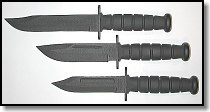 The "Freedom Fighter" series builds upon the Spec Plus line with many of the identical blades, textured epoxy powder coated finish for all the knives and substantially improved molded Kraton handles with solid steel butt caps, along with a flat steel double guard. The new handles, which
duplicate the stacked leather handles of the traditional pilot survival knife
to a great degree, definitely felt better in the hand and side by side with the Spec-Plus handles the difference is obvious. Prices range from $31 to
$49, depending on blade, there are seven styles including Quartermaster,
Survival and Combat in the range of what we'd consider utility and survival
style. A combination leather and Cordura nylon sheath is provided.
Unfortunately, these are not equipped with a lanyard hole, so are not suitable
for survival use, a frustrating omission on these and many other potentially
useful Ontario knives.
The "Freedom Fighter" series builds upon the Spec Plus line with many of the identical blades, textured epoxy powder coated finish for all the knives and substantially improved molded Kraton handles with solid steel butt caps, along with a flat steel double guard. The new handles, which
duplicate the stacked leather handles of the traditional pilot survival knife
to a great degree, definitely felt better in the hand and side by side with the Spec-Plus handles the difference is obvious. Prices range from $31 to
$49, depending on blade, there are seven styles including Quartermaster,
Survival and Combat in the range of what we'd consider utility and survival
style. A combination leather and Cordura nylon sheath is provided.
Unfortunately, these are not equipped with a lanyard hole, so are not suitable
for survival use, a frustrating omission on these and many other potentially
useful Ontario knives.
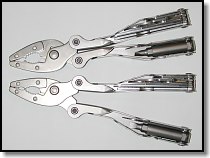 Schrade's latest "Tough Tool" ($80), model ST5E (is had no identifying name to separate it from the regular Tough Tool), features slip-joint pliers, a first for a conventional folding multi-purpose tool (Spyderco's unique SpydeRench is so equipped). As with conventional pliers, the slip-joint allows the pliers to
effectively hold larger and thicker stuff, considerably enhancing their
usefulness. Closer to a conventional pliers configuration as opposed to needle
nose, the pliers jaws also incorporate both a conventional large gripping area
at the throat, just forward the wire cutters, and a smaller gripping area
forward near the tips. As before, the pliers are of laminated
construction.�
Schrade's latest "Tough Tool" ($80), model ST5E (is had no identifying name to separate it from the regular Tough Tool), features slip-joint pliers, a first for a conventional folding multi-purpose tool (Spyderco's unique SpydeRench is so equipped). As with conventional pliers, the slip-joint allows the pliers to
effectively hold larger and thicker stuff, considerably enhancing their
usefulness. Closer to a conventional pliers configuration as opposed to needle
nose, the pliers jaws also incorporate both a conventional large gripping area
at the throat, just forward the wire cutters, and a smaller gripping area
forward near the tips. As before, the pliers are of laminated
construction.�
One handle contains a locking clip point blade and wood saw, metal file/saw, large flat screwdriver and sheepsfoot utility blade.� The other handle contains only a bit adapter with a double-ended Phillips #2 and medium flat screwdriver.� The adapter locks in both the 90-degree and fully extended positions, a nice feature.� Unfortunately, there is no storage in the sheath for additional 1/4-inch hex drive bits.
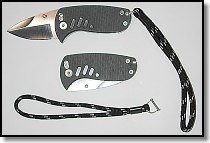 Schrade's "Spitfire LTD" ($115) introduces their iteration of an ambidextrous locking mechanism with the stud moving in the vertical plane
(patent pending, of course). The 2-inch ATS-34 modified drop point blade has
ambidextrous opening studs.� Liners are stainless with G-10 scales, the knife is a compact 3.125 inches closed.
Schrade's "Spitfire LTD" ($115) introduces their iteration of an ambidextrous locking mechanism with the stud moving in the vertical plane
(patent pending, of course). The 2-inch ATS-34 modified drop point blade has
ambidextrous opening studs.� Liners are stainless with G-10 scales, the knife is a compact 3.125 inches closed.
An attached wrist lanyard is secured via a small shackle that is attached to the butt of the knife.� It can be released by simply squeezing the blade when closed.� We're not sure we like the idea, it seems to open the possibility of inadvertent release, but we'll withhold judgment until we can test one.
 The "Nitro" ($65)� and "Silhouette" ($60) are liner lock folders that share the same blades.� The 2.975 inch modified drop point blade of 420a stainless is retained in anodized aluminum handles, 4-inches closed. The Nitro also incorporates molded rubber handle inserts that Schrade refers to the as "gel" and were expecting some sort of squishy material, as found on some pens and such, but it is much firmer and not particularly distinguishable from other rubber inserts we've experience with.
The slim reversed-over-itself design pocket clip is attached at the tip of the butt end for minimum knife exposure, but is non-reversible, non-ambidextrous.� There is a small lanyard hole.
The "Nitro" ($65)� and "Silhouette" ($60) are liner lock folders that share the same blades.� The 2.975 inch modified drop point blade of 420a stainless is retained in anodized aluminum handles, 4-inches closed. The Nitro also incorporates molded rubber handle inserts that Schrade refers to the as "gel" and were expecting some sort of squishy material, as found on some pens and such, but it is much firmer and not particularly distinguishable from other rubber inserts we've experience with.
The slim reversed-over-itself design pocket clip is attached at the tip of the butt end for minimum knife exposure, but is non-reversible, non-ambidextrous.� There is a small lanyard hole.
The "Viper" ($60) and "Black Ice" ($65) folder lines are another pair that share blades with the handles and pocket clip the only differences. The blade is very nearly a spear point, 3.5 inches of 420a stainless. One-hand opening is via a oval hole. The liner lock is not recessed at all, so we'd be very concerned about inadvertent unlocking the blade in use. The Viper has anodized aluminum handles, the Black ice has translucent black
polycarbonate with a pair of slim rubber inserts, both 4.25 inches long closed.
Both have a small lanyard hole.� The pocket clips are non-reversible, non-ambidextrous attached for tip down carry. The one on the Black Ice is a reversed over itself design for minimum exposure.
 The "SEAL Revolver" ($75) from SOG incorporates both a
4.75-inch knife blade and wood saw into a fixed blade knife�of sorts. The tang
of one is the blade of the other and they rotate, "revolve," in the handle for
access. Carried in a Kydex sheath, this is an attempt to provide the benefits
of a fixed blade with the alternate availability of a wood saw without having
to add any weight or go through the rigmarole of a blade exchange with
attendant storage issues as well.
The "SEAL Revolver" ($75) from SOG incorporates both a
4.75-inch knife blade and wood saw into a fixed blade knife�of sorts. The tang
of one is the blade of the other and they rotate, "revolve," in the handle for
access. Carried in a Kydex sheath, this is an attempt to provide the benefits
of a fixed blade with the alternate availability of a wood saw without having
to add any weight or go through the rigmarole of a blade exchange with
attendant storage issues as well.
The AUS 9 stainless blades are locked into position by the pivot point and a second locking pin about halfway down the blade.� The prototype locked up hard with no movement. There's no way it's a solid as a true full tang fixed blade, but it's also far more secure than a typical folder. The handle is Zytel with a lanyard hole in the� locking lever that extends out the butt of the handle.
The blade shape is very similar in shape to that of SOG's SEAL Pup with a deep clip point and plain edge; the wood saw is an aggressive double tooth style.� A TiNi black coated blade is an available option for $85.
 SOG's "Twitch I" ($40) and "Twitch II" ($55) are a sibling pair of assisted opening folders with 1.9 and 2.7 inch AUS 8 stainless modified drop point blades, respectively. Assisted opening is very quick via either the thumb stud or a flipper.� The flipper adds a little to the guard up front on the handle, but not as much as many others.
SOG's "Twitch I" ($40) and "Twitch II" ($55) are a sibling pair of assisted opening folders with 1.9 and 2.7 inch AUS 8 stainless modified drop point blades, respectively. Assisted opening is very quick via either the thumb stud or a flipper.� The flipper adds a little to the guard up front on the handle, but not as much as many others.
 Locking is via a innovative two-piece lockbar that splits at the fore end to allow the flipper to stick through.� Behind the lock release is a slide safety to prevent inadvertent opening.� Handles are hard anodized satin finish aluminum, 2.85 and 3.5 inches closed, respectively.� There is no pocket clip, a lanyard hole is provided.
Locking is via a innovative two-piece lockbar that splits at the fore end to allow the flipper to stick through.� Behind the lock release is a slide safety to prevent inadvertent opening.� Handles are hard anodized satin finish aluminum, 2.85 and 3.5 inches closed, respectively.� There is no pocket clip, a lanyard hole is provided.
 The "Groove" is a new Kydex sheath incorporating an innovation designed and patented by Rob Hanna, a SEAL instructor. A slit in the sheath
allows the knife edge to be used as a line or webbing cutter without removing
the knife from the sheath. This can be especially valuable when working around
inflatables or to others in the vicinity that don't appreciate an inadvertent
poke with a sharp knife tip--a poke that could really ruin your day. This is
another one of those palm-to-the-forehead-why-didn't-I-think-of-that sort of
ideas. Certainly a potentially viable alternative to carrying a separate line
cutter.
The "Groove" is a new Kydex sheath incorporating an innovation designed and patented by Rob Hanna, a SEAL instructor. A slit in the sheath
allows the knife edge to be used as a line or webbing cutter without removing
the knife from the sheath. This can be especially valuable when working around
inflatables or to others in the vicinity that don't appreciate an inadvertent
poke with a sharp knife tip--a poke that could really ruin your day. This is
another one of those palm-to-the-forehead-why-didn't-I-think-of-that sort of
ideas. Certainly a potentially viable alternative to carrying a separate line
cutter.
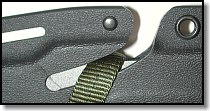 The final slit configuration will be slightly different than shown and SOG is also still working on a release mechanism for the sheath to allow it to be quickly and easily deployed as a line cutter while still retaining all the security and function as a knife sheath, however it is attached to one's gear.
The final slit configuration will be slightly different than shown and SOG is also still working on a release mechanism for the sheath to allow it to be quickly and easily deployed as a line cutter while still retaining all the security and function as a knife sheath, however it is attached to one's gear.
Once in production, the Groove will become the standard sheath for the SEAL Pup and
SEAL Knife 2000. The sheath will also be available separately for those that
already have a knife and just want the new Groove sheath. SOG guestimated cost
will most likely in the $20-$25 range.� Eventually they expect to include the Groove sheath as standard with additional knives such as the X-42 Recondo, Tigershark and possibly others.�
 It's Spyderco's silver anniversary (25th) and the limited edition "C76 Anniversary Knife" is the company's way of celebrating. Based on the Delica, a Spyderco classic, the really exceptional part is the bug and web pattern Damascus forged by� Ed Schempp
of Ephrata, Washington, and used as bolsters.� This is truly an outstanding example of Ed's work, incorporating the Spyderco logo in the damascus. The remaining portion of the handle is covered in honey-colored jigged-bone scales. Both are mounted on a stainless frame.
It's Spyderco's silver anniversary (25th) and the limited edition "C76 Anniversary Knife" is the company's way of celebrating. Based on the Delica, a Spyderco classic, the really exceptional part is the bug and web pattern Damascus forged by� Ed Schempp
of Ephrata, Washington, and used as bolsters.� This is truly an outstanding example of Ed's work, incorporating the Spyderco logo in the damascus. The remaining portion of the handle is covered in honey-colored jigged-bone scales. Both are mounted on a stainless frame.
I was somewhat surprised that the VG-10 blade is plain edged, given it was Spyderco, after all, who popularized serrated blades with its trademark SpyderEdge.� This edge treatment has come to be synonymous with Spyderco.� With the damascus and jigged-bone, each knife is subtly different, no two will be identical. There will only be 500 serialized knives produced with a cocobola rosewood presentation case for a suggested list of $350. Good luck finding one at that price��
 A collaboration with South African Ed Scott has resulted in
the "C73 Impala." The 3.687 inch VG-10 blade is available either plain edged ($160)
or with having a gut hook with plain edge or partial serrations ($170). Being traditionalists and members of the KISS brigade, we prefer the simple plain edge version. This one also has a ridged finger rest on top of the spine over the tip for better control when skinning.�
The blade also features ridges on the Syderco hole hump and the choil.� There's a stainless liner lock, G-10 scales and a sleeved lanyard hole is provided. The clip is fixed for
tip-down right-hand carry and it is recessed into a slot milled in the G-10
handle.
A collaboration with South African Ed Scott has resulted in
the "C73 Impala." The 3.687 inch VG-10 blade is available either plain edged ($160)
or with having a gut hook with plain edge or partial serrations ($170). Being traditionalists and members of the KISS brigade, we prefer the simple plain edge version. This one also has a ridged finger rest on top of the spine over the tip for better control when skinning.�
The blade also features ridges on the Syderco hole hump and the choil.� There's a stainless liner lock, G-10 scales and a sleeved lanyard hole is provided. The clip is fixed for
tip-down right-hand carry and it is recessed into a slot milled in the G-10
handle.
 Did the world really need another folding saw, and from Spyderco yet? � It's a fair question, but Spyderco needs to
protect its trademark hole and thus we have the modest sized (5-inch AUS-6
blade) lock-back folding "T02 SpyderSaw" ($60). This is bigger than those you'll
find in a typical folding knife or multi-purpose tool, but smaller than the
Gerber or Buck (or similar) offerings. Just right for some, though the price is
much steeper than most.
Did the world really need another folding saw, and from Spyderco yet? � It's a fair question, but Spyderco needs to
protect its trademark hole and thus we have the modest sized (5-inch AUS-6
blade) lock-back folding "T02 SpyderSaw" ($60). This is bigger than those you'll
find in a typical folding knife or multi-purpose tool, but smaller than the
Gerber or Buck (or similar) offerings. Just right for some, though the price is
much steeper than most.
The FRN handles include an integral pocket clip, though at 1/8 inch short of six inches long closed, we expect the clip will more likely be used in a pack or similar carriage.� There is no denying that the one-hand opening is convenient and we can think of plenty of times it would have come in handy on the trail.�
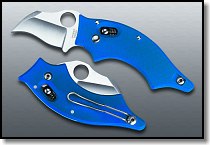 Eric Glesser (Spyderco owner Sal's son) designed the "C80 Dodo"as an answer to the restrictions on blades that are found in many areas. That means you need a short and often inoffensive appearing blade, but typically that also leaves you with a short and not easily gripped handle (Spyderco's Cricket being a relevant example, which is now available as the C29 Cricket SS ($65), as in all stainless steel). The Dodo tries to address those issues with a short 2.062 inch long blade of S30V stainless that should be legal just about anywhere that blades are allowed with a downward curving tip (similar to that of Spyderco's Cricket), which is obviously not designed for thrusting, but still provides a sharp tip for all the utilitarian needs we carry knives for, or for slicing defensively if needed. The recurved edge is available plain edged or serrated, and adds working length without adding to the overall length. Every little bit helps with a short blade like this.
Eric Glesser (Spyderco owner Sal's son) designed the "C80 Dodo"as an answer to the restrictions on blades that are found in many areas. That means you need a short and often inoffensive appearing blade, but typically that also leaves you with a short and not easily gripped handle (Spyderco's Cricket being a relevant example, which is now available as the C29 Cricket SS ($65), as in all stainless steel). The Dodo tries to address those issues with a short 2.062 inch long blade of S30V stainless that should be legal just about anywhere that blades are allowed with a downward curving tip (similar to that of Spyderco's Cricket), which is obviously not designed for thrusting, but still provides a sharp tip for all the utilitarian needs we carry knives for, or for slicing defensively if needed. The recurved edge is available plain edged or serrated, and adds working length without adding to the overall length. Every little bit helps with a short blade like this.
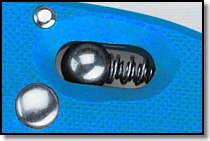 The 4.062 inch long handle is royal blue G-10. There's a deep finger choil and wide finger scallops for a full-sized grip. This knife introduces a new ambidextrous locking mechanism, the "Ball Bearing Lock." A pea-sized stainless steel ball bearing is spring loaded to drop into a recessed area in the blade's tang to lock the blade open. Once in place, the ball is compressed, providing a secure lock. To unlock the blade, pull back on the ball, accessible on either side of the handle. Our initial impression was that this is not as easy as it sounds; the smooth surface of the small ball deep in the recess of the handle providing little purchase with which to pull. Sweaty, wet or oily hands would only compound this issue. However, in all fairness, we'll reserve judgement until we can spend some time with the lock.
The 4.062 inch long handle is royal blue G-10. There's a deep finger choil and wide finger scallops for a full-sized grip. This knife introduces a new ambidextrous locking mechanism, the "Ball Bearing Lock." A pea-sized stainless steel ball bearing is spring loaded to drop into a recessed area in the blade's tang to lock the blade open. Once in place, the ball is compressed, providing a secure lock. To unlock the blade, pull back on the ball, accessible on either side of the handle. Our initial impression was that this is not as easy as it sounds; the smooth surface of the small ball deep in the recess of the handle providing little purchase with which to pull. Sweaty, wet or oily hands would only compound this issue. However, in all fairness, we'll reserve judgement until we can spend some time with the lock.
There's an ambidextrous flexible wire pocket clip. Overall length of the Dodo is 6.125 inches (156mm) and weight is 2.5 oz (71g). Spyderco declined to provide a price, the knife won't be available until later this year, but given the S30V premium steel and G-10 scales, plus the new lock, this is likely to be more rather than less expensive.
 Spyderco also showed off some prototypes, "mostly for dealer/media opinions," that we're always happy to provide. No lack of opinions around here. Look for these most likely later this year, though no guarantees.
Spyderco also showed off some prototypes, "mostly for dealer/media opinions," that we're always happy to provide. No lack of opinions around here. Look for these most likely later this year, though no guarantees.
An all stainless version of the slim C75 Kiwi was presented, sleek looking in solid polished metal. It retains the 2-inch wharncliff blade and one of the most ergonomically comfortable handles we've seen in a slim knife like this; 3.187 inches over all length. Price was estimated to be about $75.
 The "C79PS Assist" has a number of feature that we liked. This is a lockback design featuring the David Boye style recess in the lock, with FRN handles having four deep finger scallops with the front integral guard also have ridges to assist in preventing slippage. The blade opener is Spyderco's hole topped with its Cobra Hood that forms a wide and steep thumb ramp when open. The blade is shallow, making it easy to slip under a safety belt, with a estimated 20/80 plain and serrated edge. The tip itself is absolutely blunt, even extending below the blade edge a wee bit for added protection for a victim. The spin of the blade is scalloped, so the hand can comfortably and securely cup the blade if desired. The wire pocket clip is ambidextrous, but unfortunately there's no lanyard hole. At least with the wire clip, a lanyard or split ring could be attached to it. Still, we'd prefer one somehow; a hollow fastener for the pocket clip perhaps?. Things happen and often such knives are used in situations where they can be inadvertently dropped and lost. That becomes more than an inconvenience, at that point it can further imperiled the victim being rescued.
The "C79PS Assist" has a number of feature that we liked. This is a lockback design featuring the David Boye style recess in the lock, with FRN handles having four deep finger scallops with the front integral guard also have ridges to assist in preventing slippage. The blade opener is Spyderco's hole topped with its Cobra Hood that forms a wide and steep thumb ramp when open. The blade is shallow, making it easy to slip under a safety belt, with a estimated 20/80 plain and serrated edge. The tip itself is absolutely blunt, even extending below the blade edge a wee bit for added protection for a victim. The spin of the blade is scalloped, so the hand can comfortably and securely cup the blade if desired. The wire pocket clip is ambidextrous, but unfortunately there's no lanyard hole. At least with the wire clip, a lanyard or split ring could be attached to it. Still, we'd prefer one somehow; a hollow fastener for the pocket clip perhaps?. Things happen and often such knives are used in situations where they can be inadvertently dropped and lost. That becomes more than an inconvenience, at that point it can further imperiled the victim being rescued.
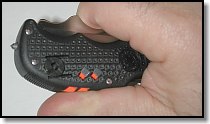 As for getting to that victim, a carbide glass breaker remains concealed in the butt end of the handle until needed. Access to the glass breaker is accomplished by simply squeezing the closed knife, which is pretty nifty. Squeeze and out it pops. Price is estimated to be $90, $83 without the pop-out glass breaker. All in all, this rescue knife appears to have been very well thought out, we came away with a very good impression.
As for getting to that victim, a carbide glass breaker remains concealed in the butt end of the handle until needed. Access to the glass breaker is accomplished by simply squeezing the closed knife, which is pretty nifty. Squeeze and out it pops. Price is estimated to be $90, $83 without the pop-out glass breaker. All in all, this rescue knife appears to have been very well thought out, we came away with a very good impression.
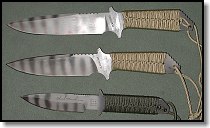 Crucible's CPM S30V stainless steel is hot at Strider Knives and Duane Dwyer explained that they will "apply it to the
majority of our product line as it applies."� All the new knives below use quarter inch thick S30V stainless. Standard finish is an a non-glare aluminum oxide and this can be done in an ersatz camo style, as shown. Sheaths are Cordura with a Kydex liner.
Crucible's CPM S30V stainless steel is hot at Strider Knives and Duane Dwyer explained that they will "apply it to the
majority of our product line as it applies."� All the new knives below use quarter inch thick S30V stainless. Standard finish is an a non-glare aluminum oxide and this can be done in an ersatz camo style, as shown. Sheaths are Cordura with a Kydex liner.
The "MK I" ($450) and "MK IA" ($425) are siblings, only the blade length is different, 7.5 and 6.5 inches, 13.5 and 12 inches overall, respectively. Blade shape is a traditional drop point with a thumb rest at the base of the spine and a large finger choil forward of the integral offset double guards. The tang is 550 MIL_SPEC parachute cord wrapped with a lanyard hole.
The "MT MOD 10," heretofore a special order knife, has become a production blade ($325) and is also available signed and endorsed by USMC Sniper, Sergeant Chuck Mawhinney ($350).� This blade is awarded by Stryder to a selected graduate of each of the following Marine Sniper School classes: 1st Division Scout Sniper School, 1st and 2nd Division Urban Sniper Schools and 1st Division Mountain Warfare Sniper Course.
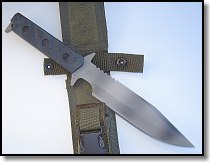 This knife is 10.25 inches overall with a 5.475 inch drop point blade. It has the usual Strider finger choil and thumb rest forward of the signature Strider double guard.� The
handle is wrapped MIL-SPEC parachute cord with a lanyard hole at the end of the tang.
This knife is 10.25 inches overall with a 5.475 inch drop point blade. It has the usual Strider finger choil and thumb rest forward of the signature Strider double guard.� The
handle is wrapped MIL-SPEC parachute cord with a lanyard hole at the end of the tang.
The "Model D9" is equipped with a 7.5 in clip point blade, 13 inches overall. Scales are either G-10 or parachute cord wrapped. Again, there's the large finger choil and thumb rest forward of a conventional integral double guard.� The rear of the signature Strider guards slope forward and there's a small pinkie ledge at the butt end of the tang, along with the lanyard hole. $425 cord wrapped, $475 with G-10.
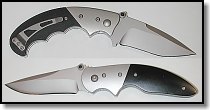 Timberline presented a pair of Greg Lightfoot liner lock designs, the "Zambezi Back Up" and the "Pistol Grip," both $80 and with identical
material specifications. Bead-lasted plain or combination edge clip point blades are 3.2 inches of AUS-8 stainless with stainless liners and tapered spacers, stainless bolster and smooth Zytel scales. Ambidextrous thumb studs feature a domes Kraton insert. A removable non-ambidextrous, non-reversible skeletonized pocket clip is set up for point up carry, but alas, no lanyard hole.
Timberline presented a pair of Greg Lightfoot liner lock designs, the "Zambezi Back Up" and the "Pistol Grip," both $80 and with identical
material specifications. Bead-lasted plain or combination edge clip point blades are 3.2 inches of AUS-8 stainless with stainless liners and tapered spacers, stainless bolster and smooth Zytel scales. Ambidextrous thumb studs feature a domes Kraton insert. A removable non-ambidextrous, non-reversible skeletonized pocket clip is set up for point up carry, but alas, no lanyard hole.
The Back Up's handles (4.9 inches) and thumb ramp closely mirror the shape of the fore end of the original Zambezi fixed blade with a pair of deep forefinger grooves and a small finger choil. The butt is tapered. The deeply curved handles of the appropriately named Pistol Grip have four deep finger grooves with an integral guard at the base of the blade and a small steep thumb
ramp. The liner lock fits the aft part of the forward finger groove on both knives.�
![]() TOPS "Tom Brown Tracker Knife" ($299), while not a personal favorite since I'm big into very simple knives, has many admirers and advocates. If the regular Tracker isn't enough to stir you, you'd still be hard pressed to not be bowled over by the beauty of this multi-function knife with Damascus steel ($650) and either blue or white linen Micarta scales.
TOPS "Tom Brown Tracker Knife" ($299), while not a personal favorite since I'm big into very simple knives, has many admirers and advocates. If the regular Tracker isn't enough to stir you, you'd still be hard pressed to not be bowled over by the beauty of this multi-function knife with Damascus steel ($650) and either blue or white linen Micarta scales.
![]() TOPS' "Shadow Tracker" ($179) fixed blade is 8.625 inches overall with a 4.125-inch drop point blade of 1095 carbon steel. The handle scales are G-10 which has been drilled in a stipple pattern, making for a good grip.� There's an integral guard, but no lanyard hole.� It comes with a Kydex sheath.
TOPS' "Shadow Tracker" ($179) fixed blade is 8.625 inches overall with a 4.125-inch drop point blade of 1095 carbon steel. The handle scales are G-10 which has been drilled in a stipple pattern, making for a good grip.� There's an integral guard, but no lanyard hole.� It comes with a Kydex sheath.
 Mike Fuller was also showing off the new "UTE-XL" and a "Strikar XL" fixed blades with some striking "brass bullet" Micarta scales.� He told us this material is used in some of the bulletproof cockpit doors being installed in airliners for anti-terrorist purposes.� Only $199 for the extra beauty;� normally $150 and $160,
respectively, with linen Micarta scales.
Mike Fuller was also showing off the new "UTE-XL" and a "Strikar XL" fixed blades with some striking "brass bullet" Micarta scales.� He told us this material is used in some of the bulletproof cockpit doors being installed in airliners for anti-terrorist purposes.� Only $199 for the extra beauty;� normally $150 and $160,
respectively, with linen Micarta scales.
 The new "BROAD Axe" ($170) which TOPS also calls the "OX-6
Hatchet," is a 6.25-inch, 30 oz. hatchet with some added utility due to its
somewhat unconventional design. It is 14.25 inches overall length of 0.25 inch
1095 carbon steel, coated black with black linen Micarta handle scales. There
is an oval hole in the head allowing you get a good grip on the head for finer
work, using the blade as a knife. A Kydex sheath is provided.
The new "BROAD Axe" ($170) which TOPS also calls the "OX-6
Hatchet," is a 6.25-inch, 30 oz. hatchet with some added utility due to its
somewhat unconventional design. It is 14.25 inches overall length of 0.25 inch
1095 carbon steel, coated black with black linen Micarta handle scales. There
is an oval hole in the head allowing you get a good grip on the head for finer
work, using the blade as a knife. A Kydex sheath is provided.
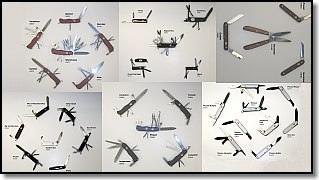 The big news from Victorinox this year wasn't really a particular knife, rather it was the major increase in the number of knives available.� For years the U.S. has had to make do with a limited selection of these Swiss Army Knives, receiving only a portion of what is available in Europe. Now, most all will be available. Thirty-Six newly available models cover the entire range from small 58mm "Classic" size knives to the large 111mm lockblades.� Some of these represent some nice combinations of tools and features from our perspective. Click here to view the new Victorinox knives (less the gardening tools) and thanks to Victorinox for the layout and photographs.
The big news from Victorinox this year wasn't really a particular knife, rather it was the major increase in the number of knives available.� For years the U.S. has had to make do with a limited selection of these Swiss Army Knives, receiving only a portion of what is available in Europe. Now, most all will be available. Thirty-Six newly available models cover the entire range from small 58mm "Classic" size knives to the large 111mm lockblades.� Some of these represent some nice combinations of tools and features from our perspective. Click here to view the new Victorinox knives (less the gardening tools) and thanks to Victorinox for the layout and photographs.
There are nine new "Silver Alox, Ribbed" (metal scales) models, as in the style of Victorinox's current Swiss military issue "Soldier."� The "Farmer" ($33) adds a wood saw to the Soldier's basic tools, a useful addition, if you don't mind the non-locking blade (we do mind). There's also a key ring added. In exchange for the robustness of the solid metal scales, you do give up the tweezers and toothpick.
The "Tinker Small" ($21) has the same good basic assortment of non-locking blades and tools as the traditional "Tinker" in the smaller 84 mm package for those looking for less bulk.
In the larger lockblade line, at the top end is the new "WorkChamp XL" ($175) with everything but the kitchen sink, including a large non-locking clip point blade to accompany the locking spear point and even a hoof pick (weighing in at 10.8 oz. and 1.625 inches thick). No belt pouch is available, a notable oversight if you ask us.
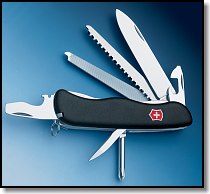 A really excellent addition to the lockblade line is the new "Locksmith" ($50 - shown at left)), basically a "Trailmaster" with a metal saw/file added. This adds only 3 mm to the width, still a comfortable to grasp and manageable size. Our only disappointment was that this didn't come in a one-hand opening
style.� The "One-Hand Trailmaster," introduced last year, remains the lone example in the line.� On the other hand, the Locksmith does have a plain edged blade, which we prefer.�
We'll keep our fingers crossed for next year.
A really excellent addition to the lockblade line is the new "Locksmith" ($50 - shown at left)), basically a "Trailmaster" with a metal saw/file added. This adds only 3 mm to the width, still a comfortable to grasp and manageable size. Our only disappointment was that this didn't come in a one-hand opening
style.� The "One-Hand Trailmaster," introduced last year, remains the lone example in the line.� On the other hand, the Locksmith does have a plain edged blade, which we prefer.�
We'll keep our fingers crossed for next year.
For those looking to impress someone with the size of your
bank account, if not your practicality, the new Classic Gold Ingot has a one
gram gold ingot issued by the Union Bank of Switzerland inlaid into the black
plastic scale of the 58mm Classic, only $90.
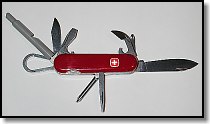 Over at Wenger, some new additions to their traditional
Swiss Army Knife line included the "Matterhorn," ($55) something of a slimmed
down "Survivor" introduced last year and including their tubular whistle and
snap shackle, and the "Zermat," ($48) which replaces the whistle with a wood
saw.� Unfortunately, neither has the locking main blade of the Survivor.� Both are equipped with a 60% serrated blade.
Over at Wenger, some new additions to their traditional
Swiss Army Knife line included the "Matterhorn," ($55) something of a slimmed
down "Survivor" introduced last year and including their tubular whistle and
snap shackle, and the "Zermat," ($48) which replaces the whistle with a wood
saw.� Unfortunately, neither has the locking main blade of the Survivor.� Both are equipped with a 60% serrated blade.
The large lock blade "Century" ($32) and "Century with Wood
Saw" ($42) introduced last year in camo, is now available with gray scales.
|
| SELECT AND USE OUTDOORS AND SURVIVAL EQUIPMENT, SUPPLIES AND TECHNIQUES AT YOUR OWN RISK. Please review the full WARNING & DISCLAIMER about information on this site. |
Publisher and Editor: Doug Ritter
Email: Doug Ritter
URL:
http://www.equipped.org/shot_show_2003_knives.htm
First Published: March 10, 2003
Revision: 03 September 5, 2003
![]()
Email to: [email protected]
|